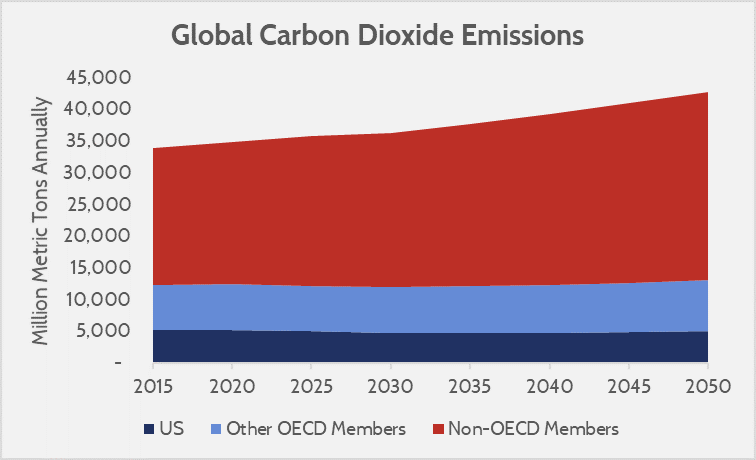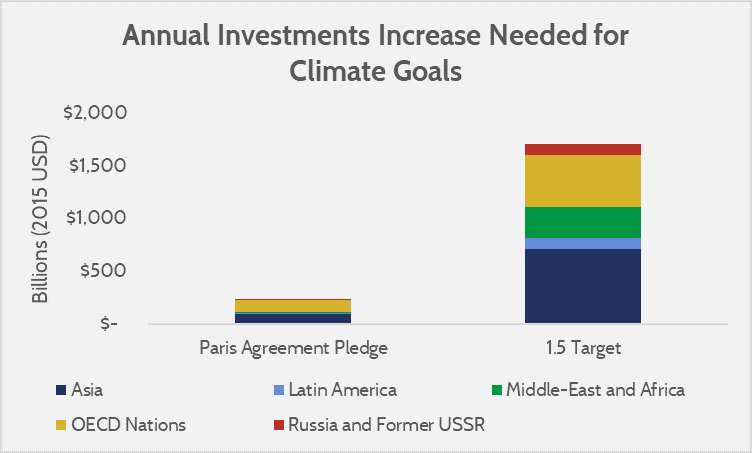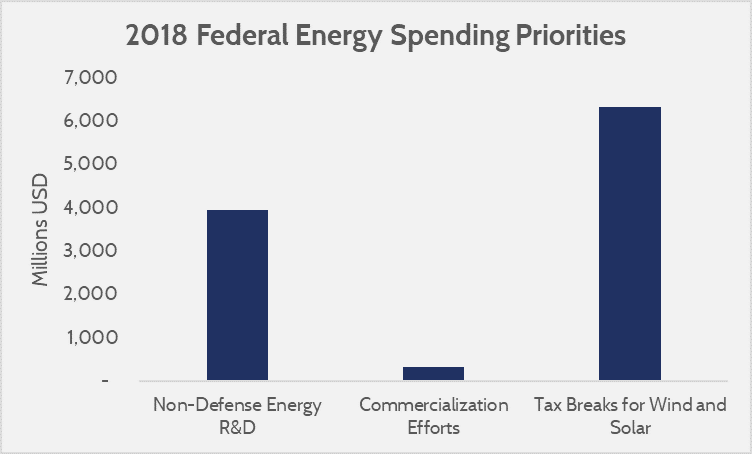Insight
July 30, 2019
Climate Solutions Need Innovation
Summary
- Most proposals for combating climate change focus on domestic emissions, but the vast majority of future emissions growth will come from developing countries that are much poorer than the United States.
- Because current methods of reducing emissions are expensive, developing countries are unlikely to adopt them, as doing so would hurt their economies and the wellbeing of their citizens.
- As a result, any effective climate policy must focus on bringing down the cost of carbon mitigation, as developing countries will only adopt mitigating policies if the advantages outweigh the disadvantages.
Introduction
The vast majority of proposed policies to address climate change are focused on the United States and domestic efforts to reduce emissions. Embedded in ideas like the “Green New Deal” is the assumption that the United States is such an important global actor in climate change, and such a large contributor to it, that American action alone can dramatically change the outlook for carbon emissions around the world. Unfortunately, the data tell a different story: The biggest challenge in climate change is growing energy consumption (and thus emissions) abroad, and particularly in nations that are on average significantly poorer than the United States.
A pragmatic strategy for climate change must account for this reality. Currently favored policies in the United States, and the West more generally, are expensive, and poorer countries are highly unlikely to adopt policies that would substantially hurt their economies. As a result, to have large impacts on future emissions, climate change policies need to be centrally focused on bringing down the costs of clean energy. In a word, the focus should be innovation.
Climate Change Is a Global Problem
The United States is the world’s second-largest emitter of greenhouse gasses behind China, with just over 14 percent of the world’s greenhouse gas (GHG) emissions, and around 16 percent of the world’s carbon dioxide (CO2) emissions. The United States’ current contribution to emissions, however, should not be confused for the amount of control the United States has over the reduction in emissions, especially over time. The United States’ share of GHG emissions is shrinking, primarily because developing nations—especially in Asia—are rapidly growing. The chart below shows projected emissions for the United States, other Organisation for Economic Co-operation and Development (OECD) members (primarily wealthy first world nations), and non-OECD members.
Source: Energy Information Administration, International Energy Outlook 2017
Notice from the chart above that 92 percent of carbon dioxide growth is expected to come from non-OECD members. These data illustrate a central truth that must guide any climate-policy choices: Stabilizing global GHG emissions will require dramatic changes in how poorer nations consume energy. To be sure, the United States has an important role to play in combating climate change; the world’s second-largest emitter must pursue domestic decarbonization as a necessary condition for mitigating rising global temperatures. But domestic emissions reductions alone are not a sufficient condition to achieve widely held climate goals.
Climate change is a global problem, and the policy responses must treat it as such. Any effective solution will require collective action from different countries with different interests, and to be effective, climate policies must take this reality into account.
The Costs of Addressing Climate Change
The mere fact that climate change is a global problem does not necessarily mean that it cannot be solved. Many global collective action problems are relatively easily ameliorated. A good example is that all pilots and air traffic controllers use English as a common language. A German pilot arriving at JFK from Berlin does not have any beneficial outcome from bucking the system and speaking German over the air, and the costs of learning fluent English are low compared to the risks of forgoing air-traffic control communications. For an environmental example, consider the Montreal Protocol, which sought international cooperation in banning the use of chlorofluorocarbons (CFCs) that were harming the ozone layer. The Montreal Protocol was a success because, even though CFCs were cheap and plentiful for aerosol applications, they were not much cheaper than alternatives, so the costs of complying with the international regulatory regime were low enough to be worthwhile (and the ozone layer is healing nicely).
The common theme in successful international agreements is that the benefits of participation are greater than the costs of compliance and participation. Failed international agreements, of which there are many, are vacated when the costs of compliance are no longer worthwhile. For climate policy this consideration of both costs and benefits is exceptionally important, because as the above data show, most of the future emissions growth will come from non-OECD nations that are prioritizing economic growth, and enjoying the ensuing benefits (declining global poverty, more education, improving lifespans, etc.). Achieving this growth means consuming energy, and the cheapest energy sources widely available are carbon intensive.
Given these realities, a reality check is in order on the capacity of non-OECD nations to absorb the costly climate policies that are favored in the United States and Europe.
These policies vary, but they all have costs. Under President Obama, roughly $457 billion of environmental regulation was implemented. The effectiveness of these policies is somewhat contentious, but nevertheless this sum offers a good benchmark of costs required to achieve only modest environmental gains. More ambitious policies come with significantly larger price tags. The lead sponsor of the Green New Deal’s House resolution, Representative Alexandria Ocasio-Cortez, has stated that a serious decarbonization agenda in the United States would cost “$10 trillion.” This figure is in line with earlier American Action Forum cost estimates of the Green New Deal resolution’s environmental proposals, which totaled between $8 and $12 trillion. An analysis by the “Risky Business Project” that assumed more efficient proposals than what politicians frequently propose estimated a long-term cost of decarbonization of around $4.8 – $7 trillion, with a peaking net annual cost of roughly $300 billion. Extrapolating that cost to households, the Risky Business model of decarbonization costs would peak at $2,351 per household annually, or about 4 percent of gross domestic product (GDP) per capita (and GDP per capita is in line with median household income)
Bearing these costs in the United States would be tough, but not nearly as difficult as in other countries. U.S. GDP per capita is significantly higher than the OECD average: $54,541 compared to the $39,936 OECD average. The OECD average is more than triple the non-OECD average of $12,055. Assuming a similar per household cost, implementing the Risky Business decarbonization scenario in non-OECD nations would require a much higher share of income—20 percent of GDP per capita, assuming the same decarbonization costs as in the United States ($2,351 / $12,055). Obviously, many factors affect what the actual costs would be, and will vary substantially from country to country. But the fact remains that residents of wealthy Western nations, which have yet to approve any dramatic decarbonization policies themselves, may be significantly overestimating the willingness of residents in developing nations to undertake similar policies.
Scholars have been attempting to identify the total breadth of investment required to prevent global temperature increases from reaching 2 degrees Celsius, or even 1.5 degrees Celsius. The International Energy Agency (IEA) estimated that the cumulative global new investment required (that is, investment in clean energy beyond what is already anticipated) to remain below 2 degrees Celsius of warming is $44 trillion through 2050. A different analysis, published in World Scientific, estimated that the same 2 degree target would require a cumulative $45 trillion of investment through 2050, which was the mean value in a range between $30 – $75 trillion. The same authors of that study did another analysis to estimate the costs for a 1.5 degree target, which estimated that the required increase in investment above current investment expectations would be $1.6 trillion per year, or $48 trillion over 30 years. This analysis also broke the costs down by region, displayed below. Note that these costs are undiscounted, meaning they represent cumulative costs rather than present-day costs.
Source: International Institute for Applied Systems Analysis
The fundamental takeaway is that the relative costs of decarbonization with current technology is likely to be greater for non-OECD nations than wealthier nations. The data and recent history simply do not support any assumption that countries around the world will take up aggressive climate policies, as even relatively low-cost decarbonization policies are extremely controversial in wealthier nations. If decarbonizing were cheap, it would already have been done.
A Robust Climate Strategy Demands Innovation
The above datapoints illustrate three key concerns related to climate change. One, 92 percent of the increase in global CO2 emissions will come from non-OECD nations, and those increases will overtake reductions elsewhere. Two, non-OECD nations—where emissions growth is occurring—are on average significantly poorer than their mostly wealthy and Western counterparts in the OECD. Three, attempts to estimate the costs of decarbonization, at least with existing technologies, show substantial global costs that are not concentrated only in rich countries—non-OECD nations will also face high costs for decarbonization.
Based on these conclusions, a robust climate strategy with a chance to succeed will be principally focused on how to reduce significantly the costs of clean energy or related technologies without relying on subsidies or mandates—which are expensive policies that are unlikely to be successful or popular abroad. In a word, the solution is innovation.
The United States, however, does not invest heavily in energy innovation, nor does it have a climate-focused innovation mission. The current model of U.S. energy innovation is, first, to invest a modest amount of federal dollars in energy research conducted by National Laboratories, and those dollars are not invested broadly but rather narrowly in specific technology areas (renewables, energy efficiency, nuclear, etc.). Inventions that emerge from the National Labs, or privately developed inventions, receive essentially no support that would allow the introduction of unproven technologies in the commercial sector. Instead of supporting the development of breakthroughs, already-proven technologies such as wind or solar power get the most government support in the form of subsidies (both federal and local) and regulations that explicitly require consumers to purchase their products through renewable portfolio standards. In short, current policy invests relatively little in advancement while investing much in propping up current technologies. The data indicate the opposite approach is needed.
The chart below helps to visualize the United States’ current energy policy, as it compares three major avenues of federal spending for energy in 2018. The left column is the spending of federal dollars on energy research and development for non-defense programs (energy efficiency, renewables, nuclear, fossil energy, and electricity delivery research and development programs). The center column is spending on commercialization programs (loan guarantees, and Advanced Research Projects Agency-Energy). The right column are the two largest energy tax breaks, the Production Tax Credit and the Investment Tax Credit, the vast majority of which go to wind and solar power.
Source: Department of Energy FY2019 Budget Request, Treasury Department FY2020 Tax Expenditures
A cogent innovation strategy should instead be agnostic as to what technologies are supported, and governmental support should be primarily focused on earlier-stage research and development. Federal subsidies, if any are offered at all, should be for newer technologies that struggle to attract investment. Fundamentally, a U.S. innovation strategy should be about transitioning from the existing system, where government policy heavily favors a select few technologies that have little hope of replacing fossil fuel consumption abroad, to a system that ensures new and revolutionary ideas can compete with all the advantages of incumbent technologies. Without an innovation strategy, technologies that may be game changers and more marketable abroad may never get opportunities to demonstrate their commercial value or viability.
The substantive policy changes needed for a more pro-innovation energy policy are relatively simple. Reforming the roughly $110 billion of energy subsidies that take the form of tax breaks over the next 10 years could be done in a way that is technology neutral, and also revenue neutral. Such a reform would reduce political bias and more responsibly use federal tax dollars. The Loan Programs Office, which provides guarantees to loans for new technologies, could be reformed to be more transparent and competitive to better attract high quality applicants. The National Labs’ innovation programs should have more flexibility to partner with outside organizations and maximize the utilization of their resources and technical expertise. These policy proposals are also relatively uncontroversial, as over the past two years several significant pro-innovation energy bills have been signed into law, aiming at easing regulations for clean energy and encouraging private-public partnerships with the National Labs.
Conclusion
Truly effective climate policy needs to go beyond a U.S.-centric approach and deliver solutions that are viable even in countries where residents have only a fraction of the wealth of a typical American. So long as the costs of mitigating climate change remain high, garnering international cooperation to address the global problem will remain a herculean effort. Policymakers’ efforts would be better served by directly focusing on the problem: how to create a market environment that stimulates technological innovation for deploying cost-effective solutions to climate change. Only by bringing the cost of carbon mitigation down through innovation will it become possible to forge a binding global agreement that successfully mitigates climate change.













